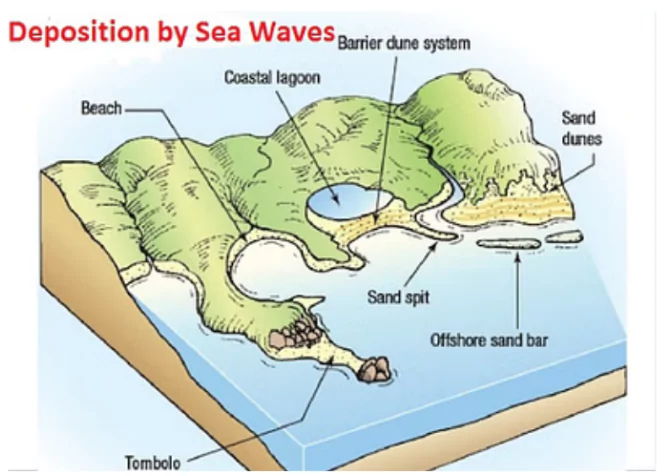Introduction
Coastal depositional landforms are dynamic features shaped by the interaction of land, sea, and sediment. From the ever-shifting sands of beaches to the lagoons nestled between barrier islands, these formations offer a glimpse into the intricate processes at work along the coastline. Through the accumulation of sediments and the influence of waves and currents, a diverse array of landscapes emerges, each with its own unique characteristics and ecological significance.
Exploring Coastal Depositional Landforms and Geographic Features
- Beaches: Beaches are not permanent and can change in size and composition seasonally by the continuous action of waves.
- They are formed by the accumulation of sand and pebbles along the shoreline.
- Dalmatian Coast: This is the longitudinal coast where mountains run parallel or concordant to the coast.
- Dunes: Sand lifted and sorted from the beach surface is deposited just behind the beach, forming sand dunes.
 These are commonly found along low sedimentary coasts and appear as long ridges parallel to the coastline.
These are commonly found along low sedimentary coasts and appear as long ridges parallel to the coastline.
- Off-shore Bar: It is a ridge of sand and shingle that forms in the sea in the off-shore zone, typically running parallel to the coast.
- They offer the first buffer or defence against a storm or tsunami.
- Barrier Bar: It is an off-shore bar that becomes exposed due to the accumulation of sand.
- Spit: Spits are elongated depositional landforms that extend from the coast into a body of water, typically formed by longshore drift, where waves transport and deposit sediments along the coast.
- When barrier bars and spits form at the mouth of a bay and block it, a lagoon is formed.
- Tombolos: It connects an island to the mainland or another island;
- it is created by the deposition of sediments by waves and tides, which gradually build up to connect the two land masses.
Enroll now for UPSC Online Course
- Lagoons: Lagoons are shallow, often brackish water bodies located between barrier islands or spits and the mainland, formed when sandbars or spits enclose an area of water behind them.
- Estuaries: are partially enclosed coastal bodies of water where freshwater from rivers and streams mixes with seawater.
- The deposition of sediments from river runoff creates unique habitats.
- Mudflats: soft, muddy sediments exposed during low tide.
- Salt Marshes: Coastal wetlands dominated by salt-tolerant vegetation, formed by the deposition of fine sediments carried by tidal waters.
Strait and Isthmus
- Strait: naturally formed waterway that connects two large water bodies.
- Isthmus: A narrow strip of land that connects two larger land masses and has water on either side.
Gulf and Bay: Gulfs and bays are both water formations along coastlines.
- Gulf
- Size and Shape: generally larger and more extensive indentations of the coastline.
- Degree of Enclosure: more open connection to the ocean or sea
- Bay
-
- Size and Shape: Typically smaller and shallower compared to gulfs.
- Degree of Enclosure: may have a narrower entrance compared to gulfs.
|
Conclusion
- Coastal depositional landforms are integral components of coastal ecosystems, offering both protection and habitat diversity.
- From the sandy shores of beaches to the intricate networks of salt marshes and estuaries, these formations play a vital role in shaping the coastal environment.
- As natural processes continue to shape and reshape these landscapes, understanding and preserving these dynamic features becomes essential for the sustainability of coastal communities and ecosystems alike.
![]() April 27, 2024
April 27, 2024
![]() 6125
6125
![]() 0
0
 These are commonly found along low sedimentary coasts and appear as long ridges parallel to the coastline.
These are commonly found along low sedimentary coasts and appear as long ridges parallel to the coastline.